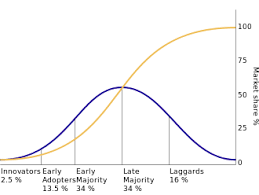After attending a WARC seminar on marketing effectiveness last month, I left with a strong impression that many recent findings in marketing science are struggling to find acceptance in marketing and my own profession of market research. A recent book Eat Your Greens, published by APG, dives deeper into many of these marketing insights and perhaps it’s time to grasp their implications for how we condict market research.
The fallacy of heavy and light brand users
In many research studies, we studiously separate heavier and lighter users of specific brands to understand why they are different. The marketing science data shows that on average they are not. When studied over longer time periods, all brands follow a predictable distribution of sales and the vast majority of consumers are “light users”.
Heavier usage may reflect heavier involvement in the category, associated with habitual behaviour rather than “brand love”, but heavier users often become lighter users at a later point in time (regression to the mean). In general, sales growth comes from growing the number of buyers of a brand and not the frequency of buying.
Lesson #1 for market research: focus more on the underlying category drivers rather than specific brand users and “heavy” buyers.
The importance of understanding mental associations versus product “features”
One of the most important ways that brands are remembered and recalled is through mental associations with a particular context (time, place, social situation) which are linked to specific brand assets (colour, symbol, sound, smell). These mental associations work in networks with one triggering the other, and these triggers are particularly important at point of sale.
Research shows that these associations have far more impact on brand choice than the typical features and attitudes that are often the focus of research. In this respect, brand choice is like voting, at the end of the day people vote for the “values” they believe in rather a laundry list of policies.
Lesson #2 for market research: understand the mental associations of a brand both with the context of use and its most distinctive assets that trigger purchase and consumption.
The implicit mind is more important than the explicit brain
There is overwhelming evidence that the short and long-term health of brands comes from emotional appeals that resonate with customers (up to eight times more impact in advertising).
That doesn’t mean that all brands and advertising need to be “happy, happy” but rather that emotions act as the most important of all memory triggers, linking a brand to relevant context and customer needs and to the feelings that are associated with its use. This is critical for understanding the long-term health of any brand.
Lesson #3 for market research: Too much research focuses on very rational (explicit) questions, and we need to find practical approaches that capture implicit emotional responses.
Why research findings should always be placed in a local cultural context
Perhaps the most important aspect of context is local culture, especially in Asia with its huge population and diversity of people and cultures. Rather than researching the demographics of your target customers, consider researching the values of the “tribe” your client wishes to influence.
Cultural context creates the strongest emotional engagement with audiences, and this is consistently seen in the most effective advertising campaigns across Asia. For example, recent campaigns by Ariel in India (“Share the load”) and SKII in China (“Marriage market takeover”) demonstrate the value of culturally informed advertising campaigns to create emotionally powerful and distinctive communication with huge impact on both brand sales and social change.
As Umma Saini writes, “In a low attention economy, people will always have time for things that matter to them deeply”. Or to adapt a well-worn cliché, “culture eats brand strategy for lunch”.
Lesson #4 for market research: Bring cultural insights to the heart of many more research projects and not an occasional afterthought when standard approaches don’t work.
[This article was originally published by Asia Research.]






